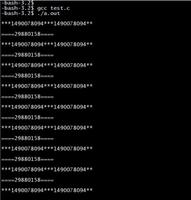加密并随机生成盐
所以我正在尝试bcrypt。我有一类(如下所示,该类来自http://www.firedartstudios.com/articles/read/php-
security-how-to-safe-store-your-
passwords),其中包含3个功能。第一个是生成随机的Salt,第二个是使用第一个生成的Salt生成哈希,最后一个是通过将提供的密码与哈希密码进行比较来验证所提供的密码。
<?php/* Bcrypt Example */
class bcrypt {
private $rounds;
public function __construct($rounds = 12) {
if(CRYPT_BLOWFISH != 1) {
throw new Exception("Bcrypt is not supported on this server, please see the following to learn more: http://php.net/crypt");
}
$this->rounds = $rounds;
}
/* Gen Salt */
public function genSalt() {
/* openssl_random_pseudo_bytes(16) Fallback */
$seed = '';
for($i = 0; $i < 16; $i++) {
$seed .= chr(mt_rand(0, 255));
}
/* GenSalt */
$salt = substr(strtr(base64_encode($seed), '+', '.'), 0, 22);
/* Return */
return $salt;
}
/* Gen Hash */
public function genHash($password) {
/* Explain '$2y$' . $this->rounds . '$' */
/* 2a selects bcrypt algorithm */
/* $this->rounds is the workload factor */
/* GenHash */
$hash = crypt($password, '$2y$' . $this->rounds . '$' . $this->genSalt());
/* Return */
return $hash;
}
/* Verify Password */
public function verify($password, $existingHash) {
/* Hash new password with old hash */
$hash = crypt($password, $existingHash);
/* Do Hashs match? */
if($hash === $existingHash) {
return true;
} else {
return false;
}
}
}
/* Next the Usage */
/* Start Instance */
$bcrypt = new bcrypt(12);
/* Two create a Hash you do */
echo 'Bcrypt Password: ' . $bcrypt->genHash('password');
/* Two verify a hash you do */
$HashFromDB = $bcrypt->genHash('password'); /* This is an example you would draw the hash from your db */
echo 'Verify Password: ' . $bcrypt->verify('password', $HashFromDB);
?>
现在,例如,如果我生成带有“密码”的哈希,我将得到一个哈希密码,该密码采用了随机生成的Salt。接下来,如果我再次输入“
password”并使用验证功能,我将得到true表示密码匹配。如果输入错误的密码,我将得到错误的密码。我的问题是这怎么可能?随机生成的盐又如何呢?怎么没有效果呢?
回答:
很好地了解您正在处理的价值观。产生的随机盐为:
abcdefg...馈入的内容crypt如下所示:
crypt($password, '$2y$10$abcdefg...') | | |
| | +- the salt
| +- the cost parameter
+- the algorithm type
结果看起来像:
$2y$10$abcdefg...123456789... | | | |
| | | +- the password hash
| | +- the salt
| +- the cost parameter
+- the algorithm type
换句话说,结果哈希的第一部分与crypt函数的原始输入相同;它包含算法类型和参数, 和哈希结果。
Input: $password + $2y$10$abcdefg...Output: $2y$10$abcdefg...123456789...
^^^^^^^^^^^^^^^^^
first part identical
确认密码后,您将再次 需要
相同的原始盐。只有使用相同的盐,才能将相同的密码散列到相同的散列。而且它仍然存在于散列中,其格式可以按crypt原样传递给它,以重复与生成散列时相同的操作。这就是为什么需要将密码和哈希值都输入到验证功能中的原因:
crypt($passwordToCheck, '$2y$10$abcdefg...123456789...')crypt会采用第一个定义的字符数(最多包括)abcdefg...,并将其余的字符丢弃(这就是为什么salt必须为固定数量的字符的原因)。因此,它等于以前的操作:
crypt($passwordToCheck, '$2y$10$abcdefg...') 同时,并且会生成相同的哈希$passwordToCheck。
以上是 加密并随机生成盐 的全部内容, 来源链接: utcz.com/qa/434712.html




